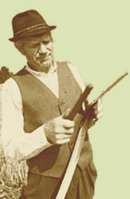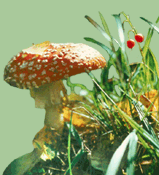The forest has ears and the sea has eyes
Ivar Tamm recalls the early days of the ELF (Estonian Fund for Nature) and gives an overview of the main activities of the fund in the 20 years. It is important to stress that ELF is not a governmental institution nor is it dependant on any other institution. ELF is a environmental foundation created to safeguard the biological diversity in Estonia and the world. The past times are also remembered by Suzanne Mittenthal, Rein Kuresoo, Ahti Heimla and Toomas Trapido.
The radio memories of the ELF
Toomas Jüriado takes us back to the early 1990ies: the activities of the ELF went up on the air quite often. During the first year, the name ELF came up in about 25 radio shows; but the real work started in 1992, when ELF had its own show: half an hour once a month. In later years the cooperation weakened, but ELF was still mentioned quite often.
Landscape design and mining culture
Rein Einasto takes a glance at mining mineral resources and looks for solutions to reconcile miners and local people. He proposes the use of short-perspective quarries that will later be turned into beautiful small lakes, which please the eye and needs of the local people.
Volunteers in nature protection
Agni Kaldma and Tarmo Tüür speak highly of the work of volunteers in bee and warding off oil pollution. ELF has probably the highest number of volunteers among Estonian environmental organizations. In many cases, the volunteers have to participate in different rescue actions, such as dealing with oil pollution, cleaning oil-polluted birds or putting down forest fires. Another important sector of volunteer work is the bee work. During 2001−2010 some 222 bees have been organized with about 4000 participants.
Economy needs changes
Agur Paesüld looks at the world and Estonia, based on the size of ecological footprint. He points out, with the help of a large figure, that world economy and societys ecological footprint are too tightly connected − as the economy grows, so does the ecological footprint.
ELF and large predators
Peep Männil calls to mind the decisive events in the protection of large predators − mostly wolf and lynx. ELF has participated in several international projects and perspectives for the protection of large carnivores look really good.
The story of flying squirrel
Uudo Timm and Jaanus Remm keep an eye on the life of the heraldic animal of the ELF. When the ELF was founded in 1991, very little was known about many endangered mammal species, the flying squirrel among them. Since then, the activities and suitable habitats have been regularly monitored. Estonian is one of the two EU countries to still have flying squirrel habitats. However, in recent years the suitable habitats have decreased and the current nature protection means are not enough to avoid the extinction of the flying squirrel in Estonia.
Endangered breeds and aboriginal breeds
Kaia Lepik introduces several domestic aboriginal breeds and endangered breeds, which should be consciously protected as part of the biological diversity. In Estonia, there are 5 such breeds: the aboriginal cattle breed, three horse breeds and the Estonian quail. Moreover, there is the Estonian aboriginal sheep breed, which has not so far been recognized as an independent breed.
Nature protection areas in the work of ELF
Silvia Lotman takes a look at the role of the ELF in creating several large protected areas. This was one of the first tasks of the newly founded ELF. Already in 1993 the Soomaa National Park and the Karula National Park were founded, in 1994 the Alam-Pedja Nature Reserve and Puhatu Nature Reserve were created. Nowadays ELF concentrates on sea habitats and possible foundation of marine protected areas and keeps busy with participating in writing management plans for protected areas.
Interview: Environmental-friendly agriculture will pay off
Juhan Javoið has interviewed Kristjan Piirimäe.
Conversation: The future is in green nature.
Conversation between Rainer Nõlvak, chairman of the council, Jüri-Ott Salm, chairman of the board, Ivar Tamm, member of the board and Eerik Leibak, the nature protection expert of the ELF. The conversation was directed and recorded by Toomas Kukk.
Two decades in cooperation with seals
Mart Jüssi recalls the research of seals and related protection works in the past two decades. Seal research was one of the first systematic undertakings of the ELF, as seals reflect the overall health of the Baltic Sea. Despite of many breaks in the research, Estonia has become one of the leading countries in seal research in the whole world.
A quick glance at the protection of forest biological diversity
Liis Kuresoo and Kaupo Kohv evaluate forest protection: regardless of advances, a lot remains to be done in Estonia. The aim to have 10% of forest land out of active use is still to be met: currently 9.5% of the forests are unmanaged. However, also the rest 90% should be managed in the way that supports the network of protected areas.
Marine habitats are also worth protection
Ele Vahtmäe describes the newest results of the research done on the marine shallows of the Baltic Sea: the marine habitats of Gretagrund and Krassgrund deserve the status of protected areas. The author outlines the main characteristics of the both areas and lists the main findings of the research.
Young nature protectors should be recognized as well as supported
Helen Alumäe introduces the laureates of the Young Nature Protector prize through the years, including 2011 prize winner − Indrek Tammekänd. The statute of the prize was founded in 2005 by Kaja and Aleksei Lotman and the ELF. So far the annual prize has been awarded to 7 young nature protectors from different sectors: be it state sector, private or non-governmental sector.
Estonian Nature enquires
Jüri-Ott Salm writes about the future plans of the Estonian Fund for Nature.
Arvo Järvet explains why the water level of rivers rises in cold periods.
|


![[IN ENGLISH]](images/gb.gif)





